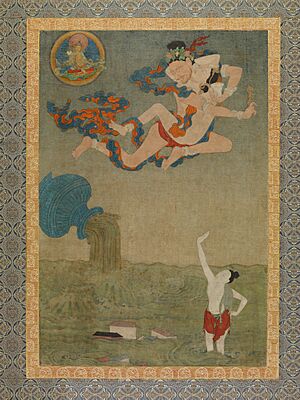Mahasiddha facts for kids
A Mahasiddha is a special kind of yogi. The word comes from Sanskrit. It means 'great achiever'. Mahasiddhas are important in Tantra, a spiritual practice. You can find them in both Hinduism and Tibetan Buddhism. They are known for their unique ideas. They also reach very high levels of spiritual understanding.
Mahasiddhas were real people who lived long ago. They were believed to have special powers. These powers came from their deep spiritual practice. A Mahasiddha is like a bodhisattva. This means they could reach a state of perfect peace, called nirvana. But they choose to stay in the world, called samsara. They do this to help other people.
In both Hindu and Tibetan Buddhist traditions, there are 84 Mahasiddhas. The lists of these 84 people are not always exactly the same. However, many Mahasiddhas appear on most lists. In Tibetan Buddhist art, you often see them in paintings. For example, they might be painted around the edge of a thangka.
Who Are Some Important Mahasiddhas?
Each Mahasiddha is known for certain things. One very well-known Mahasiddha is Virupa. He is a saint of the Sakyapa group. He lived in India in the 9th century. He was famous for his great spiritual achievements.
Other important Mahasiddhas include:
- Marpa: He was a great translator. He was the first native-born guru in Tibet. He brought important Buddhist teachings from India to Tibet.
- Milarepa: He was Marpa's student. In Buddhist pictures, Milarepa is often shown with his right hand cupped to his ear. He does this to show he is listening carefully to the teachings.
- Karmapa: He was the first lama in Tibet. He was believed to be reborn on purpose.
- Nagarjuna: A very important philosopher.
- Naropa: A great teacher and scholar.
- Saraha: Known as one of the earliest Mahasiddhas.
- Tilopa: A famous Indian master.
Images for kids
-
Four Mahasiddhas (18th century, Boston MFA). Saraha in top left, Dombhi Heruka top right, Naropa bottom left, and Virupa bottom right.
See also
 In Spanish: Mahāsiddha para niños
In Spanish: Mahāsiddha para niños




